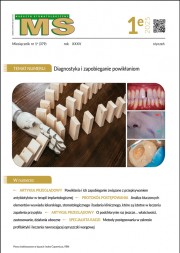Dostęp do tego artykułu jest płatny.
Zapraszamy do zakupu!
Po dokonaniu zakupu artykuł w postaci pliku PDF prześlemy bezpośrednio pod twój adres e-mail.
Malocclusions in 8-12-year-olds – treatment needs and the demand for treatment
Prowadzone na całym świecie badania potwierdzają problem licznego występowania wad ortodontycznych u dzieci w wieku szkolnym i konieczność ich wcześniejszego rozpoznawania i leczenia niż dotychczas. Badacze w wielu ośrodkach naukowych na świecie wykorzystali do tego dwa wskaźniki ortodontyczne IOTN (Index of Orthodontic Treatment Need) i DAI (Dental Aesthetic Index). Wskaźnik IOTN składa się z dwóch komponent: zdrowotnej (Dental Health Component, DHC) i estetycznej (Aesthetic Component, AC). Potrzebę leczenia ortodontycznego przedstawiono w procentach, różnicując ją z zapotrzebowaniem na takie leczenie. Uczeni zauważyli, że względy estetyczne oraz samoocena małych pacjentów w znacznym stopniu wpływają na zapotrzebowanie na leczenie ortodontyczne i odgrywają dużą rolę w podjęciu przez pacjenta leczenia.
Studies carried out all over the world confirm the problem of a great incidence of orthodontic defects in school-age children and the need for their earlier recognition and treatment than has until now been the case. Researchers in many academic centres throughout the world made use of two orthodontic indices, the IOTN (Index of Orthodontic Treatment Need) and the DAI (Dental Aesthetic Index). The IOTN is composed of two components: health (Dental Health Component, DHC) and aesthetics (Aesthetic Component, AC). The need for orthodontic treatment is presented as a percentage, to differentiate it from the demand for such treatment. The workers noticed that aesthetic considerations and self-assessment by the small patients influence, to a significant extent, and play a significant role as to whether the patient undertakes treatment.














